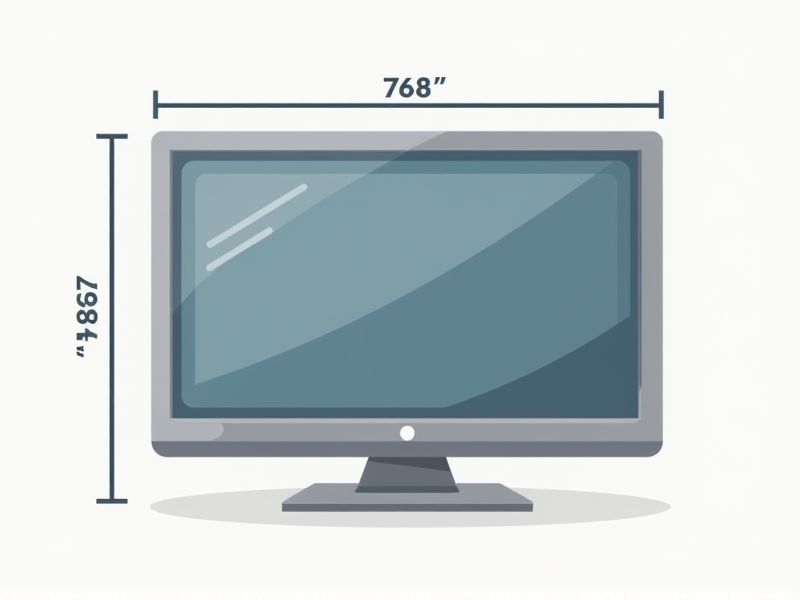
When selecting a TV, it's helpful to understand the standard dimensions associated with popular screen sizes. For instance, a 43-inch TV typically measures about 38 inches wide by 22 inches tall, while a 55-inch TV usually comes in at roughly 48 inches wide by 28 inches tall (excluding the stand). Keep in mind that these measurements refer to the actual display area, as the screen size is measured diagonally from corner to corner. Considering these standard dimensions allows you to better visualize how a TV will fit in your space and make sure you choose the right size for your room.
Aspect Ratio
Aspect ratio is a critical specification in television screens, commonly expressed as a ratio of width to height. The most prevalent aspect ratios for modern televisions are 16:9, suitable for HD and 4K content, and 4:3, which was standard in older models. You might notice that the aspect ratio significantly impacts your viewing experience, especially for cinematic films designed in a wider format, such as 21:9. Understanding these ratios ensures you select a TV that aligns with your content preferences and enhances your visual experience.
Screen Size
When choosing a TV, screen size is a critical factor that significantly impacts your viewing experience. Popular sizes range from 32 inches for smaller rooms to a gigantic 85 inches or more for immersive home theaters. Research indicates that a viewing distance of 1.5 to 2.5 times the screen size enhances picture quality and comfort; for instance, a 55-inch TV should ideally be viewed from 6.9 to 11.5 feet away. Consider your room layout and existing furniture to find the optimal screen size for your needs.
Resolution
The standard resolution for high-definition televisions is 1920 x 1080 pixels, commonly known as Full HD. For even sharper images, 4K TVs boast a resolution of 3840 x 2160 pixels, offering four times the pixel density of Full HD. In contrast, the latest 8K TVs present a staggering resolution of 7680 x 4320 pixels, delivering a total of over 33 million pixels. Choosing the right resolution enhances your viewing experience, making the details in movies and games more vibrant and immersive.
Viewing Distance
The optimal viewing distance for a 55-inch television is typically between 6.5 to 11.5 feet, ensuring a comfortable visual experience without straining your eyes. For larger models, such as a 75-inch TV, the recommended distance increases to around 9.5 to 15.5 feet. This standard varies based on resolution; for instance, 4K TVs allow closer viewing distances compared to 1080p screens, enhancing image clarity. Ensuring you maintain appropriate distances not only improves your viewing pleasure but also preserves your eyesight over long viewing sessions.
Bezel Thickness
Bezel thickness significantly impacts a television's overall aesthetic and viewing experience, with modern TVs typically featuring bezels as thin as 1 mm to 5 mm. A thinner bezel enhances immersive viewing by maximizing screen real estate, making the display appear larger and more engaging. Many consumers prefer ultra-slim bezels, as they contribute to a sleek, contemporary design that complements home decor. When selecting a TV, consider how the bezel thickness aligns with your style preferences and spatial requirements for optimal enjoyment.
Wall Mount Compatibility
When selecting a TV, ensure it has VESA (Video Electronics Standards Association) mount compatibility, typically available in various sizes such as 75x75 mm, 100x100 mm, or larger for bigger screens. Most modern televisions also support weight capacities ranging from 50 lbs to over 150 lbs, making it crucial to check your wall mount specifications against your TV's weight. The appropriate wall mount not only enhances your viewing experience but also maintains safety, with adjustable mounts allowing viewers to tilt or swivel for optimal angles. Remember, a proper installation height is generally recommended at eye level when seated, which is approximately 42 inches from the floor for an average viewing position.
Display Technology
The focus on display technology in TVs has evolved significantly, with 4K and 8K resolution becoming standard benchmarks for clarity and detail. OLED and QLED panels dominate the market, offering superior contrast ratios and color accuracy through advanced pixel technology. Many models now incorporate HDR (High Dynamic Range) capabilities, which enhance brightness and expand the color spectrum for a more immersive viewing experience. As of 2023, the average screen size of new TVs continues to rise, with over 55 inches now being the common preference among consumers, reflecting a shift towards larger, more engaging screens in home entertainment.
Refresh Rate
The refresh rate of a television, measured in hertz (Hz), indicates how many times the image is updated per second, with common standards being 60Hz, 120Hz, and 240Hz. A higher refresh rate, such as 120Hz, provides smoother motion for fast-paced content, enhancing your viewing experience during action scenes and sports events. Modern TVs often feature technology like motion interpolation, which can create additional frames to improve fluidity further. For gamers, a refresh rate of 120Hz or higher can significantly reduce motion blur, resulting in a more immersive experience.
Pixel Density
Pixel density, measured in pixels per inch (PPI), is crucial for TV quality, influencing image sharpness and clarity. Higher pixel density means finer details, with modern 4K TVs typically offering around 300 PPI or more, significantly enhancing your viewing experience. TVs with lower pixel density may display noticeable pixelation, especially on larger screens exceeding 55 inches. Therefore, when selecting a TV, consider both resolution and pixel density to ensure vibrant and crisp picture quality.
Weight
The standard focus for television weight typically ranges from 15 to 75 pounds, depending on screen size and type. Most flat-screen TVs, including LED and OLED models, generally weigh between 20 to 50 pounds for sizes spanning 40 to 65 inches. When mounting your TV, ensure that the bracket can support at least 1.5 times its weight for safety and stability. For optimal viewing experience, the TV should be positioned at eye level, approximately 42 to 55 inches from the floor.
